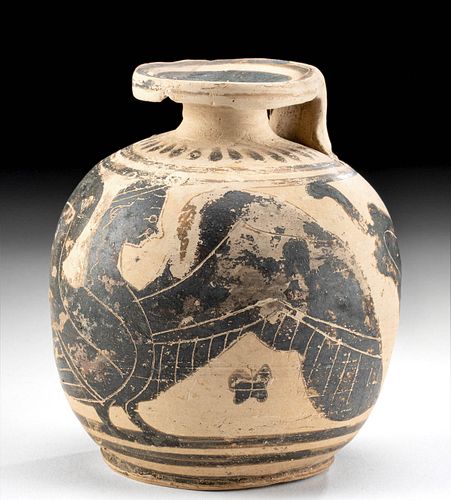Ancient Greek Corinthian Pottery Aryballos w/ Harpy
Lot 33
About Seller
Artemis Fine Arts
686 S Taylor Ave, Ste 106
Louisville, CO 80027
United States
Selling antiquities, ancient and ethnographic art online since 1993, Artemis Gallery specializes in Classical Antiquities (Egyptian, Greek, Roman, Near Eastern), Asian, Pre-Columbian, African / Tribal / Oceanographic art. Our extensive inventory includes pottery, stone, metal, wood, glass and textil...Read more
Categories
Estimate:
$700 - $1,050
Absentee vs Live bid
Two ways to bid:
- Leave a max absentee bid and the platform will bid on your behalf up to your maximum bid during the live auction.
- Bid live during the auction and your bids will be submitted real-time to the auctioneer.
Bid Increments
| Price | Bid Increment |
|---|---|
| $0 | $25 |
| $300 | $50 |
| $1,000 | $100 |
| $2,000 | $250 |
| $5,000 | $500 |
| $10,000 | $1,000 |
| $20,000 | $2,500 |
| $50,000 | $5,000 |
| $100,000 | $10,000 |
| $200,000 | $20,000 |
About Auction
By Artemis Fine Arts
Jul 22, 2021
Set Reminder
2021-07-22 10:00:00
2021-07-22 10:00:00
America/New_York
Bidsquare
Bidsquare : Summer Antiquities & Ethnographic Art Auction
https://www.bidsquare.com/auctions/artemis-gallery/summer-antiquities-ethnographic-art-auction-7245
Travel around the world and back in time...and be amazed at the treasures you will find! Antiquities from Egypt, Greece, Italy and the Near East, Asian, Pre-Columbian, African / Tribal / Oceanic, Native American, Spanish Colonial, Russian Icons, Fossils, Fine Art, much more! Artemis Fine Arts info@artemisfinearts.com
Travel around the world and back in time...and be amazed at the treasures you will find! Antiquities from Egypt, Greece, Italy and the Near East, Asian, Pre-Columbian, African / Tribal / Oceanic, Native American, Spanish Colonial, Russian Icons, Fossils, Fine Art, much more! Artemis Fine Arts info@artemisfinearts.com
- Lot Description
Ancient Greece, Corinth, ca. early 6th century BCE. An attractive aryballos, a vessel used to hold scented oils and perfumes in the bath, with a classic apple-shaped form, a circular flat rim, and a wide strap handle. The body is decorated with a large harpy standing upon petite avian feet with open wings, a broad feathered tail, and a prominent chest supporting a long neck and an anthropomorphic head. Behind either wing is an abstract phytomorphic form similar to a seed pod. Both seed pods and the harpy are decorated with incised designs. A small border of tongue-shaped forms surrounds the neck above a set of concentric circles. Harpies were originally personifications of wind spirits, and the earliest pottery, like this one, depicts them as beautiful women with graceful bird bodies. Size: 3.5" Diameter x 4" H (8.9 cm x 10.2 cm)
During this time, Corinthian ceramics showed the influence of eastern trade connections with the city - creating art with stylized plants and animal friezes, inspired by trade with the Levant, Egypt, and Assyria. This is known as the "Orientalizing Period."
Provenance: private East Coast, USA collection; ex-private Healy collection, Studio City, California, USA, acquired over the last twenty years
All items legal to buy/sell under U.S. Statute covering cultural patrimony Code 2600, CHAPTER 14, and are guaranteed to be as described or your money back.
A Certificate of Authenticity will accompany all winning bids.
PLEASE NOTE: Due to recent increases of shipments being seized by Australian & German customs (even for items with pre-UNESCO provenance), we will no longer ship most antiquities and ancient Chinese art to Australia & Germany. For categories of items that are acceptable to ship to Australia, please contact us directly or work with your local customs brokerage firm.
#157817Vessel is professionally repaired and restored from two halves along the lower half of the body with some resurfacing and overpainting along break lines. Small area of repair and restoration to rim. Surface wear commensurate with age, light abrasions, small chips to rim, base, and handle, with some fading to pigmentation. Light earthen and mineral deposits throughout.Condition
- Shipping Info
-
All shipping is handled in-house for your convenience. Your invoice from Artemis Gallery will include shipping calculation instructions. If in doubt, please inquire BEFORE bidding for estimated shipping costs for individual items.
-
- Buyer's Premium



 EUR
EUR CAD
CAD AUD
AUD GBP
GBP MXN
MXN HKD
HKD CNY
CNY MYR
MYR SEK
SEK SGD
SGD CHF
CHF THB
THB
















